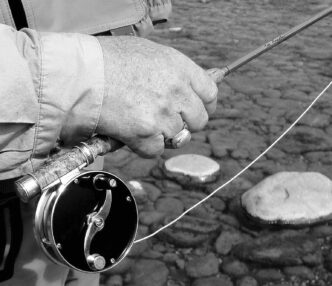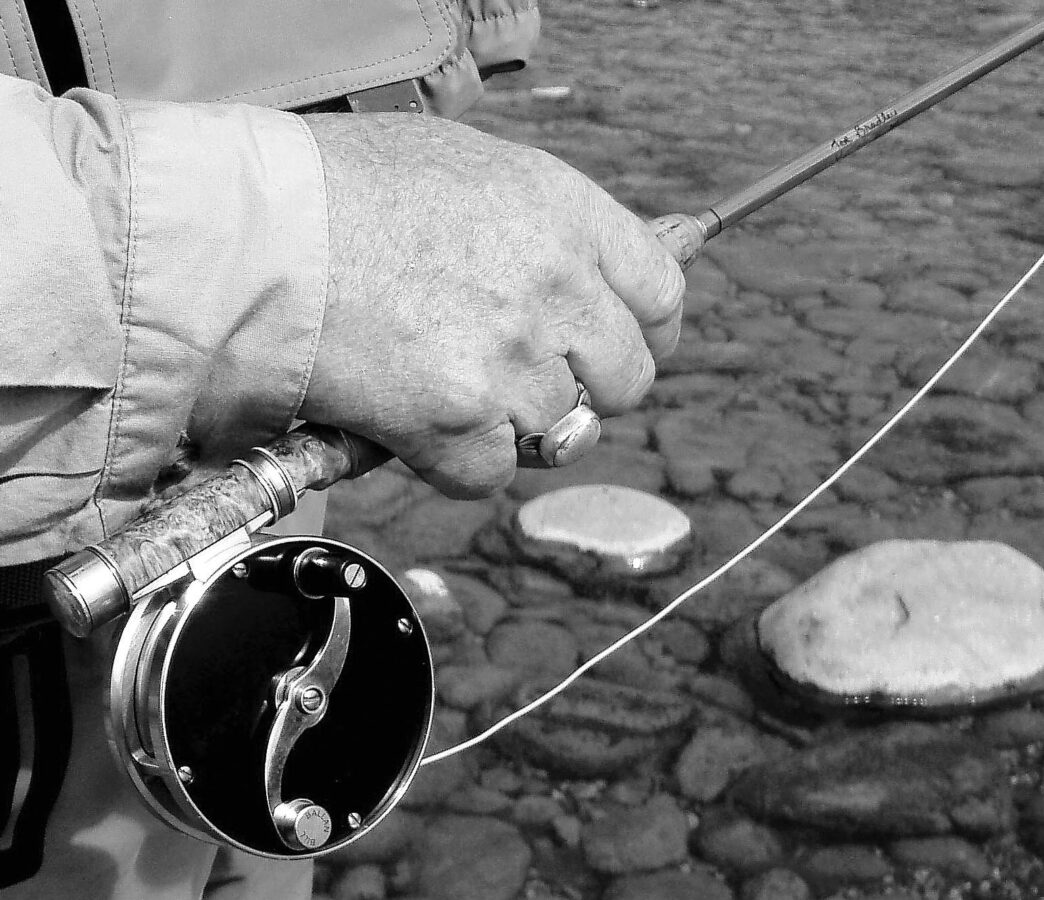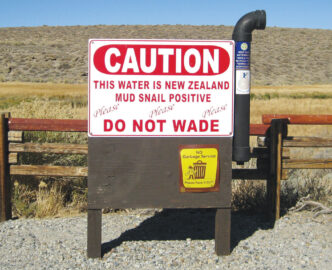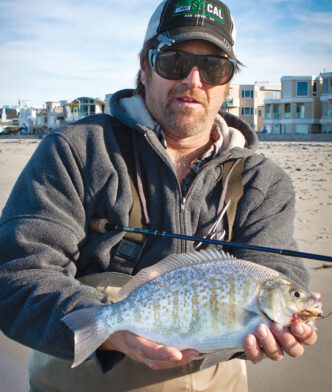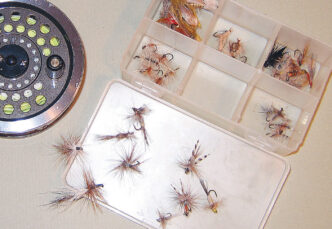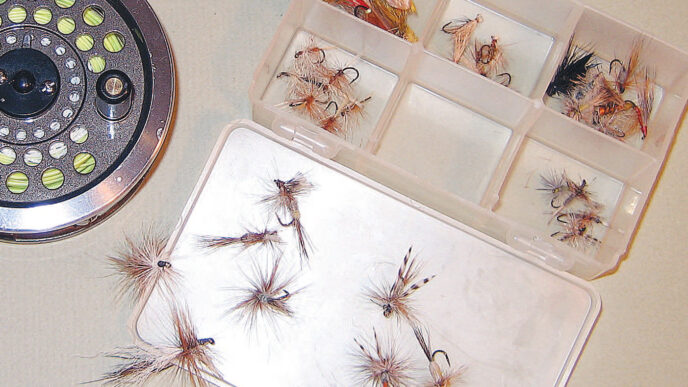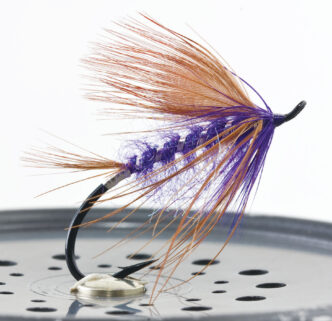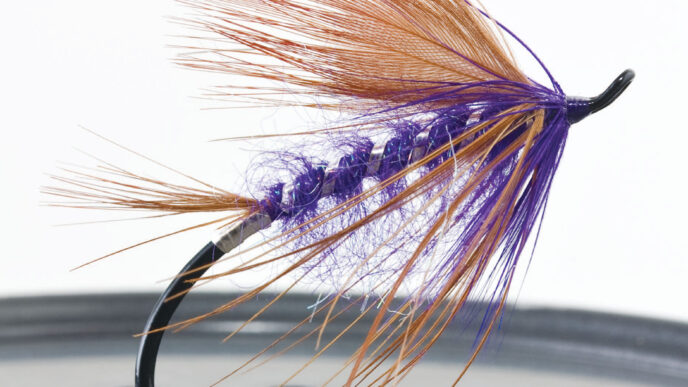When we go fly fishing, no matter how up to date our rods and tackle, we are — to borrow a phrase — borne back ceaselessly into the past. Some of us go there for the ritual. And to be a part of a tradition. And to connect to a slower, more pastoral world. And others go to rip lips and count coup. The past, as they say, is a foreign country: they do things differently there. The rods we use today are spun from carbon polymers that are at home on the Hubble Spacecraft.
Some time ago, I found myself christening a new fly rod on the meadows of Hat Creek. Or rather I should say a very old rod. My intention was to get closer to my heritage as a fly fisherman. My prop was a vintage bamboo fly rod, a Wright & McGill Granger Victory, the cheapest in the line that the now-defunct Denver company made, measuring 8-1/2 feet in length and best strung with a double-taper 5-weight or weight-forward 6-weight line.
Grangers are all the rage among many cane fly fishers these days. Once dismissed by collectors as “blue-collar cane” and “factory production rods,” these vintage sticks now fetch rather high prices. They don’t yet command the huge sums demanded of rods built by such legendary craftsmen as Hiram Leonard, E. F. Payne, and Everett Garrison, but their day will come. There are aficionados out there who prize Grangers above all others.
I don’t remember what I paid for this bottom-of-the-bin Granger. But it couldn’t have been very much — I’m famously impecunious. Probably no more than two hundred bucks tops. Cheaper by far than a new top-of-the-line graphite rod would have cost me. Mind you, this was at a time when Grangers were just beginning to catch on among collectors, but before their prices climbed to more breathtaking heights.
Rocky Mountain trout anglers historically held Grangers in high regard. In A River Runs Through It, all the Maclean men fished with Grangers. That was in the days before fiberglass and graphite changed the face of American sport fishing. Everybody fished with bamboo sticks back then, and there was a rod manufactured to fit every pocketbook. Which is why rods like the Granger Victory were built. People who are in a much better position than I am to judge these things swear that the Granger and Phillipson fly rods that rolled out of the shops in Denver actually cast as well as or better than a lot of the more famous and more expensive cane rods fashioned by the custom rod builders back East. Some fly fishers rate the Grangers and Phillipsons of that era second only to some of the rods built by Jim Payne. Although at least one person I discussed this with described a few Grangers he sampled as “heavy, mediocre casters with overly stiff butt sections.” Frankly, I’m not all that qualified to judge this, because my experience with bamboo is limited.
But the affection many hold for these rods makes sense to me. Granger rods after all were designed with Western fly fishers in mind. These were anglers who had to deal with larger rivers and lots of wind. Granger rods had a little more down their trousers, so to speak. Phillipsons even a little more so. I’ve heard Grangers and Phillipsons referred to as “Western wind rods.” Ask a Western cane angler to describe the action on a bamboo fly rod that was made in the Catskills, and he might say “weepy” or “wimpy” or “noodley.” By general consensus, Grangers and Phillipsons had more power than traditional Eastern rods and could turn a fly over in the wind with a little more authority. At the same time, they were said to be incredibly smooth to cast, sweet and supple, and would present a fly with the utmost delicacy. Highly sensitive, too — you could feel the fight in a trout all the way through a bamboo rod. They had a great reputation. There was a lot of mystique attached to Grangers — and to bamboo in general.
So when I tried out my bamboo rod, I fully expected the kind of casting that makes you go all cosmic. But consider what happened the first time I attempted to throw a loop in the air with my mail-order Granger. I flexed the rod for its maiden flight across the lawn — and much to my surprise, I didn’t hear the heavenly harmony rumored to be at large in the universe. For some reason, the rod would not load.
I had noticed, of course, the substantial heft in the rod — so different from graphite. Bamboo has more mass than carbon graphite, so consequently, bamboo rods weigh a little more. I went into my back cast — good so far — but when I came forward with my usual casting stroke, the line would not move forward sufficiently to straighten out fully. Why wasn’t my rod loading properly?
I could have blamed it on the design of the tapers or a dead spot in a ferrule. But more likely, it was my piss-poor casting technique. After all, 90 percent of what you hear in a Stradivarius is the violinist.
It finally occurred to me that I was speeding up and stopping too quickly and abruptly on the back and forward casts. I was casting as if I still had a graphite rod in my hands — and not waiting long enough for my casts to load fully under the power of the bamboo rod. I needed to recalibrate my timing, slow my casting stroke, and above all, relax. The whole idea was to let the rod do more of the work. That’s what the rod is for. When I made the adjustment, I could feel the rod filling with fluid energy, loading in a way that graphite never does.
This was more like it. Now I understood what all the fuss was about. This was nice. I was so pleased with myself that I failed to notice that I wasn’t getting much distance out of my rod. Instead, I felt ready for Carnegie Hall. I would take my Stradivarius to Burney first chance I got and play it to the rising trout on Hat Creek. I had forgotten the oldest joke in the book. How do you get to Hat Creek? Practice.
Comparing a bamboo fly rod to a violin is a rather shopworn cliché. The late Ernest Schwiebert was notorious for it. So was Arnold Gingrich, who should have known better. Gingrich was the editor and cofounder of Esquire. He was both a fly fisher and an amateur violinist of some note who owned a Strad, as well as a Guarneri and an Amati. He wrote a good book about violins called A Thousand Mornings of Music. He also wrote a trio of excellent books about the joys of trout fishing that dealt in depth with the history and literature of the sport. Gingrich once pungently declared that he would switch to fly rods made from synthetic materials on the day that Jascha Heifetz began performing on a plastic violin.
I realize that’s all part of the fun. But standing in a river waving a stick — even if you’re Brad Pitt “shadow casting” — is in no way comparable to Jascha Heifetz playing a Strad. He was said to be perhaps the only violinist on earth who could hit the high note at the end of Tchaikovsky’s Violin Concerto and give it vibrato in the fifth or so of a second in which it plays. A little less is demanded of us “artists” on stream as we wait to pull the finger out and decide what fly to use. And not even the greatest rod maker on earth is in the same league as Antonio Stradivari. But the owners of bamboo fly rods will go on pretending otherwise until the end of time.
I drove up to Hat Creek on a hot Friday in May. The meadow water in the trophy trout section downstream of Powerhouse No. 2 looked truly inviting. A dozen fly fishers were working the riffles just below the electric power lines, about at the spot where Hat Creek starts flowing out of the woods and into a large meadow. To a man, they were casting contemporary fly rods spun from the newest generation of space-age carbon fibers. I waded in well below them and worked my way down to where the riffles began to flatten and smooth out into a long, streaming glide that was as clear and flat as windowpane.
I noticed a few mayflies struggling on the surface of the lovely spring creek. The Pale Morning Duns were coming off. I found an appropriate imitation in my fly box and tied it onto my leader. I lifted the rod into a nice back cast and felt it load well into the rod. Then I made a slow, sweet cast toward the bank. And then another. A few more false casts just to get into the swing. I was soon falling into a natural rhythm, enjoying the loft and timing of the old rod.
On one of those really slow drifts that you get on Hat Creek, when you have enough time to change a flat tire, a trout rose leisurely to take my mayfly imitation. The soft, pliant tip of a bamboo fly rod is famous for providing a cushion that allows an angler to strike without snapping off the fly. I raised the rod in a smooth and gentle motion and heard a sickening crack. The terminal section on my three-piece bamboo rod broke clean in two above the second ferrule.
Holy crap! Back in the so-called “golden age” of fly fishing, in the year 1920, to be exact, an enthusiastic hobbyist by the name of Dr. George Parker Holden published a book called The Idyl of the Split-Bamboo. It was credited with starting the home fly-rod building movement. Staring in disbelief at my broken rod, the term “split cane” suddenly took on a whole new meaning.
Oddly enough, the trout was still on the end of my line. My broken rod tip bobbed on the water with each vigorous shake of the trout’s head. Cautiously and with the utmost care, I fought the trout on what remained of my broken rod. Astonishingly, I brought a 15-inch rainbow to my hand without losing him. I’d like to see Jascha Heifetz try that.
Could bamboo fly rods, I asked myself, really be this fragile? Was that why they came with two tips — one to fish while the other was at the repair shop? I walked back to the car to get my extra tip. Refitting the rod, I couldn’t help but notice for the thousandth time how gorgeous my Granger looked. Say what you will about bamboo rods, they are certainly pretty to look at. My Granger was a rich caramel color that glowed under the warmth of its varnish. That was a big part of their romance and mystique. And a painful reminder of how heartbreaking it was to destroy one.
I returned to the glassine water and tried to put some poetry back into my casts. But my mind was clouded with the fear that I might break the other tip, too. Let’s face it — bamboo fly rods are not to be placed in the hands of the ham-handed. But after a while, I got back into the rhythm. The flex in most vintage bamboo fly rods traditionally tends to be on the slow side. It can take an angler used to graphite some time to adjust. I noticed that with bamboo, everything just seemed to slow down. I could feel myself relaxing and turning very mellow. And isn’t that one of the big attractions of the sport? At least for those of us who are not into obsessively counting hookups?
What we call the “action” in a fly rod is the bend and speed generated in a rod. What we call “dampening” is the time it takes for the rod to recover. Bamboo really isn’t wood — it’s a “woodlike” grass. The natural flex of a bamboo plant is deep — and so is its recovery. Thus, the action on these so-called “classic” or “vintage” fly rods tends to be rather soft and somewhat delicate. This softer dampening stroke is the source of much of the pleasure. It can help you put an extra bit of smoothness and finesse into your casting. Although it is a truth universally acknowledged that individual casting skill far exceeds any contribution made by the spring component in a fly rod. Remember, it’s the violinist, not the violin.
At the risk of overgeneralizing, let’s say that an old-fashioned cane rod loads and releases rather slowly. At least more slowly than graphite normally does. In a well-made cane rod, this will produce a very smooth and fluid cast with a dampening effect at both the beginning and the end of the back cast. And then again at the beginning of the forward cast as line accelerates — and again at the end of the forward cast as the line settles down onto the water for what should be a gentle and precise turnover. This slow loading of the rod also allows a delicate lift of the fly off the water at the end of the float. Synthetic fly rods made from graphite and boron produce somewhat similar back and forward casts, but many of these rods, especially ones with a faster flex, lack the “feel” — that subtle dampening effect — that a well-made bamboo fly rod has in the hands of a competent caster.
You can really feel the rod flexing as the bamboo rod stores and delivers power to the line. And if you remember to stay relaxed, the rod will do most of the work. Loops tend to be a little wider, but it does not necessarily mean shorter distances or a slower line speed. The trick lies in smooth acceleration. Bamboo requires a lighter hand during the cast, thus producing greater line speed with less effort.
Faster is king in the marketplace these days, but you have to wonder what’s going on here. Every few years or so, it seems that the torch gets passed, JFKstyle, to a “new generation” of graphite that allows us to cast farther and farther on lighter and lighter carbon rods. It’s the “New Frontier.” Too often, what’s lost is finesse. Most light-tackle trout fishing takes place within 10 to 30 feet of the caster. And rarely are we called upon to cast much beyond 40 or 50 feet. A lot of those stiff, fast-action carbon fly rods won’t even begin loading at short distances. Moderate-action graphite rods will do so, though not as well as good bamboo or quality fiberglass. How many of us on a regular basis need to drop a Blue-Winged Olive in front of a rising trout at 80 feet?
I blame the fetish for faster tout rods on advertising copywriters, who are in the pay of marketers who understand that the American male is a macho guy. The persona of the modern fly angler is no longer a frail consumptive like Theodore Gordon. The logo on your fly rod is not Hello Kitty.
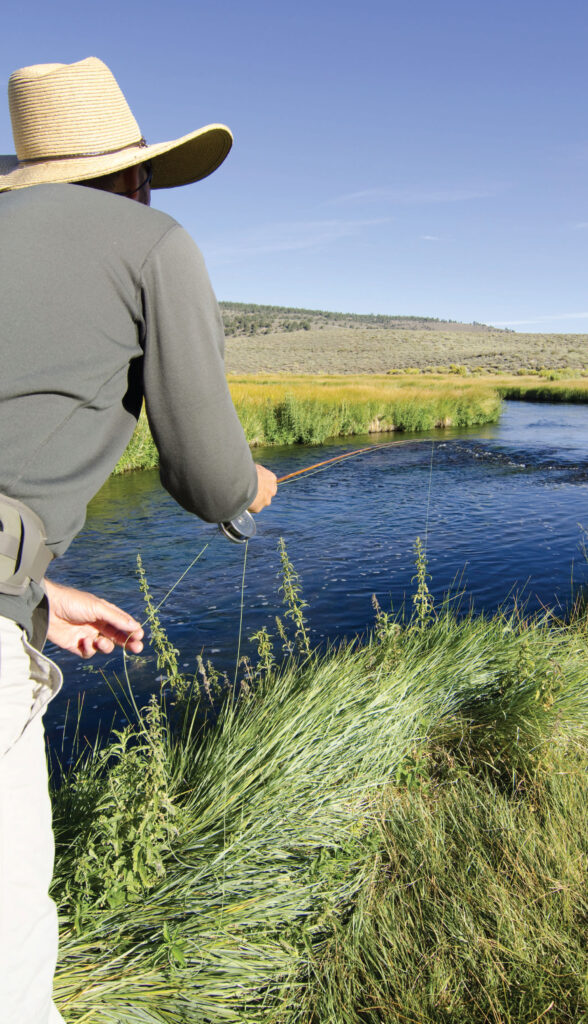
The modern angler regards graphite as “faster,” “more responsive,” and more “efficient” than bamboo. And from a practical standpoint, bamboo can present some disadvantages to the modern angler. Cane rod builders will tell you that bamboo is more durable than graphite — and I don’t challenge the science behind that assertion. But I notice that whenever I ask a fellow angler if I can try out his rod, it’s always the guy with the bamboo stick who says, “Break it, you bought it.” And half the used cane rods in those classified ads seem to be down an inch or two in at least one tip, indicating that something got broken real fast. True, bamboo is incredibly strong. The natural jujitsu in its fiber lets bamboo stand up to typhoons — bending and springing back — as giant trees get uprooted. Bamboo rods can be remarkably tough and resilient, some with enough backbone to land huge salmon and steelhead. But let’s face it, they’re high maintenance. A bamboo rod will probably outlive its owner — but it requires a great deal of tender loving care to last well. The tip sections on old bamboo rods need to be rotated frequently to minimize the inevitable “set,” a permanent bend that comes from prolonged fishing. A bamboo rod can snap at the ferrule if you overload one or throw too much heavy line into the air with too much force. That’s true of tip-heavy graphite rods, as well, but when they break, it doesn’t seem to hurt as much. (That’s because most of today’s premium graphite rods come with a guarantee of a free replacement. Which is why they cost so much in the first place — and why you damn near went into cardiac arrest when you saw the price tag.) Bamboo is prone to damage and warping if stored improperly, especially if put away while damp. Bamboo rods must be thoroughly dried before they are put back in their sock, or they will rot. If dampness works its way into a rod, say through a crack in the bamboo, it can cause the rod to break. That could explain why my tip section cracked clean in two above the ferrule when I hooked that rainbow on Hat Creek. In addition to the warping and rotting factor, in many older models, you will find “dead spots” at the ferrules, which can adversely affect the casting. That’s also true of mediocre graphite rods, but you probably didn’t pay as much for one of those. Let’s face it — there are anglers out there who own bamboo rods so valuable they don’t dare fish with them.
It can be a struggle to cast a bamboo fly rod in the wind if you are not used to your rod’s action — especially if you’re trying to make the adjustment from graphite to bamboo. It’s a little harder to form those narrow, wind-cheating loops with cane. Also, very few bamboo rods were designed for long-distance casting. This can put you at a disadvantage when fishing larger rivers or lakes. On the other hand, an expert caster can shoot an entire fly line on a bamboo rod. I’ve seen it done.
Here’s what’s so nice about bamboo. What you lose in “efficiency,” you gain in poetry. There’s just something about the way bamboo feels. Something about the flexibility and suppleness, the inherent smoothness, the incredible sensitivity in the rod tip. A bamboo rod will help you put an extra bit of grace and sweetness into your casting. Assuming, of course, you know how to cast in the first place. Nothing — not even a sonnet by Shakespeare — will put iambic pentameter into the arm of an inept caster.
A well-made bamboo fly rod, with its slower, sweeter flex, will allow you to make a very gentle presentation on the water. This is ideal for fishing dry flies to wary trout and is why so many spring-creek junkies adore bamboo. These rods start loading at relatively short distances, where a lot of your trout fishing begins. And they have the power to let you cast farther out when you need it. You have better line control, because the rod is more forgiving. You can put the fly where you want it with greater ease.
Soft bamboo excels in protecting light tippets. A cushiony rod takes a lot of the strain out of the tippet, especially on the strike. Much of that strain gets transferred and absorbed into the rod. This helps prevent broken tippets and lost trout. The suppleness in bamboo also makes fighting a fish way more fun. Even catching smaller fish becomes exciting. Many fast-action graphite rods do not flex very far down into the rod, and so there is some loss of sensitivity, especially when playing a fish. But a springy bamboo rod that bends deeply lets you feel the full weight and struggle when that fish is thrashing around at the end of your line.
I have already mentioned that bamboo is very forgiving. The flexibility and lower line speed allows better control and greater accuracy in casting, especially for a less experienced angler. While it is probably far better for a novice to learn casting on a medium-flex graphite rod, an argument can be made that a slower-action fly rod might be preferable to a stiff, fast-action rod. I know this is heresy — most flyfishing instructors believe a faster rod is easier for a beginner to master, needing only a good “speed-up and stop,” while a slower rod needs more attention to the stroke. But the high line speeds generated by very fast rods can cause beginners to struggle for control and make them sacrifice accuracy. I suppose we could argue this endlessly over many beers. Maybe we could just agree that any dope ought to be able to learn how to cast any kind of a fly rod, no matter what it’s made of. After all, it’s fishing, not neurosurgery.
One thing I have discovered is that roll casting is easier and more fun with bamboo. Especially when using those double-taper lines that bamboo lofts so well. Same with mending line and making “side,” “wiggle,” “puddle,” and “curve” casts. As for bamboo being heavier than graphite, maybe so. But if you use shorter rods, say nothing longer than 8-1/2 feet for all your light-tackle trout fishing, you should be all right. And you might not have to struggle so much over a long day of fishing if you just remember to relax, let up on the false casting, and allow the rod to do most of the work.
And then there are aesthetic considerations. The wonderful smell of the varnish when you take your rod out of the bag. The beauty and warmth of the cane. The jewel-like colors in the silken wraps. Holding a bamboo fly rod in your hand makes you feel a part of a rich and lasting heritage.
So to oversimplify: graphite is fast and efficient. Bamboo is slow and sweet. Speaking only for myself — and at the risk of starting any number of “taper tantrums” in the letters column of this magazine — let me just say this. The casting dynamics in these different rod materials can best be likened to separate, but distinct literary texts. Graphite is Fly Fishing for Dummies. Bamboo is “Ode to a Nightingale.”
Now we come to the whole snobbery thing. Bamboo rods are seen by some as elitist. Well, why not? As Toscanini said, “In life a democrat. In art an aristocrat.”
When I started fly fishing back in the late 1970s, you rarely saw anyone on the river holding a bamboo fly rod. They were out there, of course; bamboo never really went away. But it was not the rod of choice, except for a few diehards and those angling traditionalists who distrusted even high-quality glass.
The so-called “golden age” of cane was roughly from the 1920s to the early 1950s. And then two things happened to bring an era to an end. Harry Truman embargoed trade with China, the source of Tonkin cane. And the Shakespeare Company came out with their Wonderod, the first fly rod made from fiberglass. The fishing scene changed almost overnight. Many of the factories that once supplied cane rods to American anglers switched to fiberglass fly rods or spinning outfits, which became all the rage. Most of the mass producers of cane — companies such as Granger and Phillipson in Denver, and Heddon and Sons in Michigan — eventually closed their doors. A few major rod companies, such as Orvis in New Hampshire and R. L. Winston in San Francisco, continued to build cane rods. By the time the embargo on cane ended in the early 1970s, the number of bamboo rod builders in America was down to a mere handful.
Today, there is something of a renaissance in cane. Anglers are rediscovering the joys of split bamboo.
There are more bamboo rod builders in America right now than there were during the golden age. I don’t know the exact number working commercially — I think I read somewhere that it might be around two hundred — and there are probably double that number of hobbyists building rods for themselves and their friends. The consensus seems to be that the very best rods being made today are superior to even the greatest rods of yesteryear. Equipment and materials have never been simpler to obtain — especially Tonkin cane, which is available in culms or blanks. Glues, resins, and adhesives have all been improved. Cane builders have perfected better ways of smoothing out and eliminating the nodes in bamboo that can weaken a rod. A modern bamboo fly rod will rarely warp or throw a set anymore. Ferrules tend to be fitted more securely and to leave no dead spots. The masters of cane are not only recreating the great rods of yesteryear from classic tapers designed by the likes of Lyle Dickerson and E. C. Powell. They are introducing their own ideas into the split bamboo. Today’s masters can build rods tapered to a faster flex, with an action almost identical to graphite, in order to meet today’s angling tastes and casting needs. But these rods still retain the classic “feel” of bamboo. The Holy Grail, I suppose, is a bamboo fly rod that will load at short distances, but cast into infinity. It’s not your great-grandfather’s bamboo fly rod.
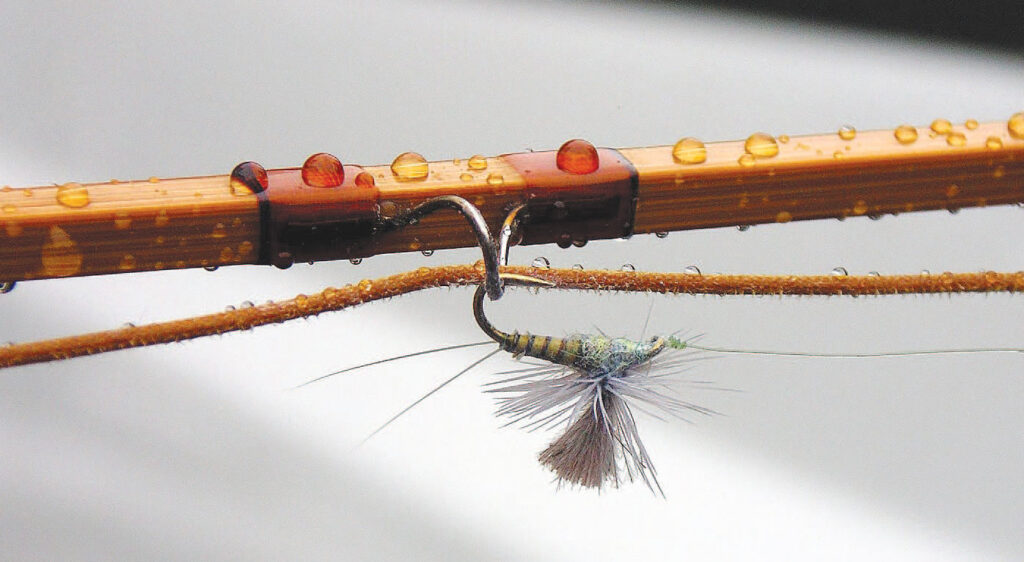
Bamboo rods are still rather uncommon. But there are enough lovers of cane out there to keep an army of bamboo rod makers fully employed. The backlog is so great that the wait for delivery on a new custom rod by the very best makers can take years. Naturally, all this has caused a run on old fly rods. Even low-end junk — those “carpet-beaters” that were once mass produced by companies such as Montague, South Bend, and Horrocks-Ibbotson — have become collectibles. Most of those vintage factory rods were fishable, but rather heavy and somewhat on the clunky side. A few were prestige models and quite sweet to cast. And so anglers who know a bargain are always on the lookout for them. Especially those anglers who believe that even “second-rate” cane is more fun to cast than the very best graphite. Fine bamboo rods cost a lot of money.
That goes without saying. Eternal optimists see the price gap eventually narrowing in the choice between bamboo and graphite. They point out that a few builders, especially those offering only one tip, are selling bamboo rods at a price more in line with what you might pay for a high-end graphite stick these days. I sup-
pose that’s one way to look at it. But I see the price of graphite climbing up to where the air is so rare you get a nosebleed. Top-of-the-line graphite rods are now going for as much as seven and even eight hundred bucks. Who designed them, Antonio Stradivari?
On the day I christened my Granger, Hat Creek’s trout were rising intermittently to Pale Morning Duns, BlueWinged Olives, and Little Yellow Stoneflies. The smooth water had all the look of a classic spring creek made in Heaven. The light, sandy bottom showed up well in the bright afternoon sun. The trout had positioned themselves in feeding lanes close by the undulating weed beds. When I spooked them, they hid under the waving elodea and lay low for a while.
I made soft casts, upstream and down, to feeding trout. It took me a while to adjust, but when I remembered to relax and slow down my casting stroke, I felt the rod become more fluid in my hand. To deal with the weeds and complicated currents, I made a lot “wiggle” casts and other fancy stuff to keep drag off the leader. Not that I’m a spring creek expert — far from it. But when the trout struck, I felt an exquisite quickening at the end of my line. The suppleness in the rod — its springy aliveness — allowed me to feel the full fight of the fish in a way no graphite rod ever did. I realize that claim is religion, not science. But I have no problem with the theological in fishing. I held the rod high to keep the thrashing fish out of the weed beds. And I’m proud to say I didn’t break it again. Later that evening, there was a caddis swarm, and I had a lot of fun with that old bamboo rod as the light drained away from the creek and the meadow.
With the evening rise over, I joined the other anglers in the dirt parking lot near the powerhouse. The talk that night was about how fine the fishing had been. I couldn’t help but notice that my fellow anglers had all been using rods made from post-Sputnik-era materials. I suppose you could say we have come a long way since the days of Hiram Leonard.
Hat Creek whispered through the dark meadow. I could make out the silhouettes of pine trees and incense cedars on the hardwood benches. A sliver of new moon hung in the sky. I took apart the old bamboo rod and returned it gently to its sack.
It has been said that the present creates the future by breaking the chains of the past. But sometimes, the past creates the future by turning away from the present. Sometimes, in order to begin anew, we return to where we began.



